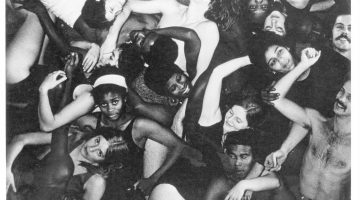by John Held, Jr.

Richard Shaw
Studio Still Life, 2013
Porcelain with over glaze decals and blown glass. Courtesy of the gallery.
If I were a major contemporary exhibiting artist, even I might be impressed if a work of mine was displayed in the American Painting Wing of a major metropolitan museum alongside the likes of James Peale (1749-1831), Raphaelle Peale (1774-1825) and William Michael Harnett (1848-1892). Richard Shaw acquired that status a decade ago when his work, “Book Jar with Ashtray,” (1980), was acquired and placed in the De Young galleries devoted to American Art. Given validation that his work stands beside the greatest of American artists, it is no wonder that Shaw is preoccupied with artistic minutia in all its forms, including artistic accouterments.
Indeed, it is here that he shines. Paint tubes alongside peanut shells, cigarette butts and ashes indicate an easy familiarity with studio practice. And why not? Shaw began his career at the San Francisco Art Institute in the mid-1960s as a painting student, eventually switching to ceramics, and went on to teach for forty-four years, both at the Art Institute and UC Berkeley, all the while accruing an impressive exhibition record (Whitney, SFMOMA, Crocker, Yale, Stedelijk, yadda yadda, yadda). He knows his way around both the classroom and the studio, and as he related to me, has a “romance with the tools.”
It’s a time of change for Shaw. Not only has he recently retired from teaching, but this is his first exhibition with Gallery Paule Anglim after showing with Braunstein/Quay Gallery since 1970, due to the retirement of Ruth Braunstein, who just turned 90. Picked up by Anglim late last year, all fifteen works in the show have been produced in the current year, a remarkable feat given the precise nature of the works.
They are of two themes: scenes from the studio and “stick figures” cobbled together from molded odds and ends (pencils, wooden sticks, screws, balls of twine, a plunger). Shaw carries forth the heritage of West Coast assemblage that came of age in the 1950s, but with a decidedly different twist. And what a twist. It’s what makes him the remarkable artist he is, for these works are not what they appear to be. They are exquisite examples of trompe l’oeil (fool the eye) rendered in porcelain with over glaze decals. Even the seemingly wooden tables and cigar boxes that support and contain the artist’s tools, residue and figures are rendered in porcelain.
Shaw draws from an arsenal of castings that he had produced over the years. They can be mixed and matched in any number of combinations. Viewing them (see his Spark episode: http://www.youtube.com/watch?v=INL-EQL0o1E), reminds one of Joseph Cornell’s workshop – stacked boxes filled with all manner of cut paper imagery, fodder for his collage and box works. To further mislead the viewer, Shaw’s over glaze decals are produced from photographically derived silkscreen prints. It’s an intuitive painters’ eye that blends it all together.
Attending UC Davis, Shaw was exposed to the work of Robert Arneson, and he has collaborated with Robert Hudson. These associations place him squarely in the “reform school” of Bay Area Funk, first codified in Peter Selz’s Berkeley Art Museum 1967 exhibition. The Bay Area has established an especially strong presence in the ceramic art world with such key figures as Arneson, Peter Voulkos, Viola Frey, Stephen De Staebler and others. Shaw easily situates himself into their company. He is a local treasure, and the current Anglim exhibition does nothing to deter his much deserved stellar reputation.
Speaking of the gallery, they have had extremely strong showings of late, and I am thinking especially of the Deborah Butterfield exhibition, which preceded the Shaw exhibition, and which also featured trompe l’oeil in her painted bronze works mimicking wooden sticks shaped as horses. Gallery Paule Anglim also represents Robert Bechtle, a “Photo Realist,” but this is something quite different as Bechtle’s paintings are obviously paintings. In the work of Shaw and Butterfield, you are hard put to understand just what you’re seeing.
The gallery is also showing collage works by Ken Graves. If the Bay Area is a hotspot for ceramics, it is equally rich in its heritage of collage work, given its association with Jess, who is also represented by Gallery Paule Anglim. Graves is in excellent company and comports himself well.
For more information visit here.








